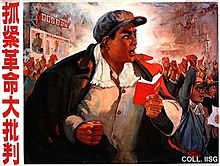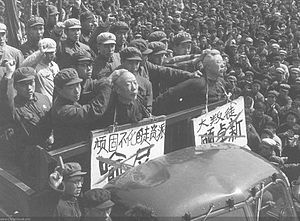- Struggle session
-
Struggle session 
Mao-era propaganda for struggle sessions Chinese name Traditional Chinese 批鬥大會 Simplified Chinese 批斗大会 Transcriptions Mandarin - Hanyu Pinyin Pīdòu dàhuì Tibetan name Tibetan thamzing Transcriptions - Wylie ‘thab-‘dzing - Lhasa dialect IPA tʰʌ́msiŋ A struggle session was a form of public humiliation used by the Communist Party of China to enforce a reign of terror in the Mao Zedong era to shape public opinion and to humiliate, persecute, and/or execute political rivals, so-called class enemies. In general, the victim of a struggle session was forced to admit to various crimes before a crowd of people who would verbally and physically abuse the victim until he or she confessed.
During Mao's rule, the Chinese people were forced to attend many different types of struggle sessions, sometimes consisting of 100,000 people. During the 1950s when the CCP began the Land Reform movement, poorer peasants seized the land from their landlords, who were given the title of exploiting class (剥削階级), and an estimated 2 million landlords were swiftly executed after being subjected to a struggle session[citation needed].
Contents
Etymology
According to Lin Yu-tang, the expression comes from 批判 [pi1pan4], meaning "to judge", and 鬥爭, meaning "to fight"; so the whole expression conveys the message of inciting the spirit of judgment and fighting. Instead of saying the full phrase 批判鬥爭:pi pan dou zhen, it was shortened to 批鬥:pi dou.
Origins and purpose
 Two Chinese citizens are branded capitalist roaders and subjected to public torture and humiliation by citizens.
Two Chinese citizens are branded capitalist roaders and subjected to public torture and humiliation by citizens.
Struggle sessions developed from similar ideas of criticism and self-criticism in the Soviet Union from the 1920s. The term refers to class struggle; ostensibly, the session is held to benefit the target, by eliminating all traces of counterrevolutionary, reactionary thinking. Chinese Communists resisted this at first, because struggle sessions conflicted with the Chinese concept of saving face, but struggle sessions became commonplace at Communist Party meetings during the 1930s due to public popularity.[1]
Accounts of struggle sessions
“ ... the Cultural Revolution began and I was transferred to another labor camp.... Two years after I had been in this new camp, I received a parcel from my family. Immediately, an inmate accused me of giving something out of it to another prisoner. I was dragged to the office. Without any investigation, the officer assembled the entire camp to start a struggle session against me. In the session the officer suddenly asked me whether I had committed my alleged original crime leading to my 8-year sentence. I was stunned. It then dawned on me that this session was in fact prearranged. The parcel was only a pretense. Their real motive was once again to force me to admit all my alleged crimes. "I did not commit any crimes," I asserted firmly. Immediately two people jumped on me and cut off half of my hair. The officer screamed again: "Are you guilty?" I replied firmly again, "No." Two people then used a rope to tie my hands back tightly. It was connected to a loop around my shoulder and underneath my armpits. It was knotted in such a way that a slight movement of my hands would cause intense pain. This struggle session lasted for two hours. Afterwards, they untied me and handcuffed me instead. The handcuffs became a part of me for the next one hundred days and nights....[2] ” “ You Xiaoli was standing, precariously balanced, on a stool. Her body was bent over from the waist into a right angle, and her arms, elbows stiff and straight, were behind her back, one hand grasping the other at the wrist. It was the position known as "doing the airplane." Around her neck was a heavy chain, and attached to the chain was a blackboard, a real blackboard, one that had been removed from a classroom at the university where You Xiaoli, for more than ten years, had served as a full professor. On both sides of the blackboard were chalked her name and the myriad crimes she was alleged to have committed.... The scene was taking place at the university, too, in a sports field at one of China's most prestigious institutions of higher learning. In the audience were You Xiaoli's students and colleagues and former friends. Workers from local factories and peasants from nearby communes had been bused in for the spectacle. From the audience came repeated, rhythmic chants.... "Down with You Xiaoli! Down with You Xiaoli!"
"I had many feelings at that struggle session," recalls You Xiaoli. "I thought there were some bad people in the audience. But I also thought there were many ignorant people, people who did not understand what was happening, so I pitied that kind of person. They brought workers and peasants into the meetings, and they could not understand what was happening. But I was also angry."[3]
” Lately, the term "struggle session" has come to be applied to any scene where victims are publicly badgered to confess imaginary crimes under the pretext of self-criticism and rehabilitation[citation needed].
Victims of struggle sessions
Ever since the Communist notion of class enemies (階级敌人) was introduced into China, terminologies such as Capitalist roader, Counter revolutionary, and running dog of the imperialist petty bourgeoisie were a part of the public discourse of revolution, acts of vigilante justice enacted by citizens and, for at least the first few years, never the army. Millions of ordinary Chinese were executed under these accusations. Mao Zedong then turned these weapons on his own comrades as leaders began to regret the loss of law and order that seemed to be destroying their previous way of life.[4]
Famous revolutionaries like Liu Shaoqi, Deng Xiaoping, Zhu De, Peng Dehuai and many more, had been subjected to repeated struggle sessions, and many of them died in prison. However, individuals like Panchen Lama after long years of public questioning, absent of torture, and imprisonment, later rejoin the Communist Party.[4]
Disuse after 1978
Struggle sessions were disowned in China after 1978, when the reformers led by Deng Xiaoping took power. Deng Xiaoping prohibited struggle sessions and other kinds of Mao-era violent political campaigns.
See also
- Zhen Fan
- Futian incident
- Anti-Bolshevik League incident
- Red terror
- Two Minutes Hate
References
- ^ Priestland, David (2009). The Red Flag: A History of Communism. Grove Press. p. 246. ISBN 9780802119247.
- ^ "A Catholic Voice Out of Communist China - November 1998 Mindszenty Report". 2008-03-13. Archived from the original on 2008-03-13. http://web.archive.org/web/20080313115857/http://www.mindszenty.org/report/1998/nov98/mr_nov98.html. Retrieved 2011-03-07.
- ^ "Enemies of the People". Worldandischool.com. http://www.worldandischool.com/public/1987/june/school-resource12592.asp. Retrieved 2011-03-07.
- ^ a b "GEDHUN CHOEKYI NYIMA GEDHUN CHOEKYI NYIMA: THE XIth PANCHEN LAMA OF TIBET". http://www.tchrd.org/publications/topical_reports/GEDHUN%20CHOEKYI%20NYIMA%20THE%20XIth%20PANCHEN%20LAMA%20OF%20TIBET/GEDHUN%20CHOEKYI%20NYIMA%20THE%20XIth%20PANCHEN%20LAMA%20OF%20TIBET.pdf. Retrieved 2011-03-07.
The Cultural Revolution
(1966–1976)Major events Key figures Mao Zedong · Liu Shaoqi · Zhou Enlai · Lin Biao · Deng Xiaoping · Gang of Four (Jiang Qing · Zhang Chunqiao · Yao Wenyuan · Wang Hongwen) · Peng Dehuai · Wu Han · Peng Zhen · Chen Boda · Wang Dongxing · Xie Fuzhi · Kang Sheng · Mao YuanxinDocuments Concepts Four Olds · Struggle session · Feudal Fascism · Two Whatevers · Big-character poster · One Divides Into Two · Democracy Wall · Eight model plays · Scar literature · Capitalist roaderGroups Red Guards · Cultural Revolution Group · Revolutionary Committee · Shanghai People's Commune · 8341 Special Regiment · The Rusticated Youth of ChinaRelated topics Categories:- Campaigns of the Communist Party of China
- Violence
- Human rights abuses
- Massacres
- Cultural Revolution
- History of the People's Republic of China
- Mao Zedong
- Democides
- Maoist terminology
- Maoist China
- Political repression in the People's Republic of China
Wikimedia Foundation. 2010.
